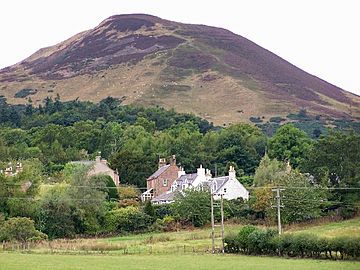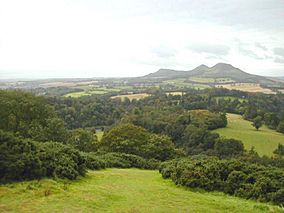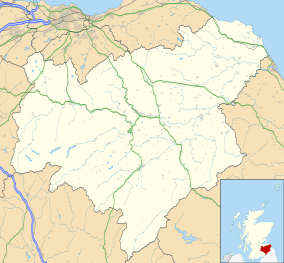Eildon Hill facts for kids
Quick facts for kids Eildon Hill |
|
|---|---|

Eildon Hill North, with Eildon Village in the foreground
|
|
| Highest point | |
| Elevation | 422 m (1,385 ft) |
| Prominence | c. 164 m |
| Listing | Marilyn |
| Naming | |
| English translation | possibly "fort Hill", "fire hill," "hill of the fenced enclosure," or "deserted hill" |
| Language of name | Old English, possibly partly Cumbric |
| Geography | |
| Location | Scottish Borders, Scotland |
| Parent range | According to Nuttall, the 1,385 feet (422 m) high "triple-crested eminence" overlooks Teviotdale to the South. |
| OS grid | NT548322 |
| Topo map | OS Landranger 73 |
Eildon Hill is a famous group of hills located in the Scottish Borders, just south of the town of Melrose. People often call them "the Eildons" or "Eildon Hills" because they have three distinct peaks.
The tallest peak is about 422 meters (1,385 feet) high. From the top, you can see amazing views of the area, especially Teviotdale to the south. The hills are owned by the Duke of Buccleuch, who is Scotland's biggest private landowner.
Even though they are privately owned, everyone in Scotland has a "right of responsible access" to the land. This means you can explore the hills and use the many paths that lead to all three summits.
The northern peak of Eildon Hill once had a huge hill fort. This ancient fort was surrounded by over 5 kilometers (3 miles) of walls. Inside, there were at least 300 flat areas cut into the rock. These were bases for houses made of turf or wood. It was one of the largest hill forts ever found in Scotland! Later, the Roman army built a signaling station on the same spot.
The Eildon Hills are part of a special area called the Eildon and Leaderfoot National Scenic Area. This area is protected because it has incredibly beautiful scenery. It covers about 39 square kilometers (15 square miles) and includes Melrose, Scott's View, and the Leaderfoot Viaduct.
Contents
Discovering Eildon Hill's Past
| Eildon and Leaderfoot National Scenic Area | |
|---|---|

The three peaks of Eildon Hill seen from Scott's View
|
|
| Location | Scottish Borders |
| Area | 39 km2 (15 sq mi) |
| Established | 1981 |
| Governing body | NatureScot |
Archaeologists have dug up clues that show people lived on Eildon Hill as far back as 1000 BC, during the Bronze Age. The walls of the hill fort were built and rebuilt three times over many years.
Inside the fort, experts have found the remains of 296 huts. This suggests that around 2,000 people might have lived there, making it a very large settlement for its time. It's believed that this hill fort was the main town for the Selgovae tribe before the Romans arrived.
Romans at Eildon Hill
In the 1st century AD, the Roman army built a huge fort called Trimontium at Newstead, right at the foot of Eildon Hill. They named it "Trimontium" because of the three peaks of Eildon Hill.
The Romans also built a signal tower on the summit of Eildon North Hill. This tower was used to send messages across the land. It was first made of wood and later rebuilt with stone.
When archaeologists dug at the site in 1986, they found Roman items on top of older native finds. This suggests that the hill fort might have been empty when the Romans built their tower. However, Roman coins and pottery found later show that some of the old hut platforms were used again between the 2nd and 4th centuries.
A Sacred Place
There's evidence that ancient people thought the Eildon Hills were a holy place. Some scholars believe it was a spot for important gatherings and ceremonies. There are also several holy springs around the base of the hills. Today, these springs are named after Christian saints, but they were probably sacred to older Celtic gods.
The name "Eildon" comes from an old word, Eldune, used in the 12th century. The "dun" part means a rounded hill. The first part, "Eil", might mean a fenced area, or it could come from words meaning "fire" or "empty place."
How Eildon Hill Was Formed
Scientists think that the Eildon Hills were formed deep underground. They might be ancient laccoliths, which are dome-shaped rock formations created when magma (molten rock) pushes up the layers of rock above it without breaking through to the surface.
Legends and Stories of Eildon Hill
Eildon Hill is famous in Scottish folklore and is often called a "hollow hill." It appears in the legend of Thomas the Rhymer, a real person from the 13th century who was said to have magical powers. Some stories say Thomas went inside the hill.
Sir Walter Scott, a famous Scottish writer, shared a tale about a horse dealer. This dealer was led inside the hill at night by an old man. Inside, he saw many sleeping knights and their leader, who was King Arthur. The dealer was shown a horn and a sword. In his confusion, he blew the horn. This started to wake the knights, and a loud voice called him a coward for not grabbing the sword first. A whirlwind then threw him out of the hill. He told his story to shepherds before collapsing from exhaustion. Scott believed the old man was Thomas the Rhymer.
Another legend talks about the Eildon Tree Stone, a large mossy rock near Melrose. This stone marks the spot where the Fairy Queen supposedly led Thomas into her magical realm inside the hills.
People also say that the wizard Michael Scot split the volcanic rock of Eildon Hill into three peaks using his magic. Sir Walter Scott wrote about this in his 1805 poem, The Lay of the Last Minstrel:
In these far climes it was my lot
To meet the wondrous Michael Scott,
A wizard, of such dreaded fame,
Than when, in Salmanca's cave,
Him listed his magic wand to wave,
The bells would ring in Notre Dame!
Some of his skill he taught to me;
And Warrior, I could say to thee
The words that cleft Eildon hills in three,
And bridled the Tweed with a curb of stone:
But to speak them were a deadly sin.
James Hogg also retold this legend in his 1823 book, The Three Perils of Man.
Eildon Hill in Music
The band Big Country mentioned Eildon Hill in their song 'Eiledon', which is on their album 'The Seer'.


